Detection of the Seasonally Activated Rural Areas
Abstract
:1. Introduction
2. Framing Seasonality
3. Materials and Methods
3.1. Spatial and Temporal Aspect of the Research
3.2. Seasonality Coefficient Based on Satellite Images of Nighttime Lights (Scos)
- Preparation of monthly series of NTL for the territory of Serbia. Monthly cloud-free DNB composites passed stray-light corrections were used [87]. The spatial resolution of the dataset was about 500 m, while NTL emission was expressed as radiance in nW/cm2/sr. Apart from numerous advantages, there were certain weaknesses related to the usage of satellite images of NTL related to blooming effect, saturation, impact of weather conditions, surface albedo, and other sources of noise [62]. Tracking population activity was additionally affected by satellite recording time, i.e., about 1:30 a.m. Also, before the final usage, additional data preparation was necessary. In this case, preprocessing included removing negative values of radiance and interpolation of excluded pixels applying the nearest-neighbor interpolation method. After the observed distribution of radiance, the outliers were removed from the analysis. Although the first release was for several months in 2012, developed algorithms in the following years enabled additional refinements of VIIRS DNB nighttime light imagery, including stray-light correction procedure [87]. To ensure the quality of used data and to avoid variability between years, average monthly NTL were calculated for a period of five years (2015–2019). The multi-year average should eliminate variability in the time series as a product of different events, natural as well as human-induced occurrences (weather conditions, fires, ephemeral light, etc.);
- Creation of a seasonality coefficient (Scos) as an indicator of area activation based on Sum of Lights (SOL). The SOL represents the sum of radiance for studied spatial units, i.e., settlements as well-selected tourist places. The seasonality coefficient for each month of the year (Scosm) was calculated as a ratio of SOL for that month (SOLm) and monthly average in the studied period (SOLaverage·m1-m12). The obtained values higher than one mean more emitted lights, i.e., an increase in ambient population compared to average conditions within a year. Exploring obtained Scosm values, the threshold of 1.25 was set up to single out settlements with the highest intra-annual variability, i.e., the largest number of months during the year when the emitted NTL are higher by 25% compared to average conditions. To show spatial patterns in seasonally activated rural areas, the obtained results are mapped;
- Case studies for selected tourist places. This kind of analysis was performed on the pixel level to get more detailed insight in spatial-temporal variability in activation for selected destinations. Additional indicator was created as the radiance ratio between the month with highest (SOLmmax) and lowest SOL (SOLmmin) within a year. This allows detection of areas within studied touristic destinations with the highest seasonal activation.
3.3. Seasonality Coefficient Based on Official Statistical Data (Scot)
3.4. Intertwining of the Seasonality Coefficients
4. Results
4.1. Seasonality Coefficient Based on Nighttime Lights (Scos)
4.2. Seasonality Coefficient Based on Official Statistics (Scot)
4.3. Intertwining of the Seasonality Coefficients
4.4. Case Study of the Rural Areas Seasonal Activation Based on the Tourist Activity
5. Discussion
6. Conclusions
- The proposed method is novel and it encourages the identification of the seasonal activation of rural areas with different purposes. We proposed a framework devised to detect and map seasonally activated rural areas.
- Despite limitations and shortcomings, NTL imagery is still one of the most widely used tools in quantitatively evaluating socioeconomic systems; also, from the correlation analysis, it can be assumed that the model works better for the specialized tourist areas. This relationship is stronger in mountain tourist areas during the winter, where there is a peak in touristic activity. It seems that the association between touristic activities and NTL, although evident, is not homogeneous in both spatial and temporal terms;
- According to the obtained results, the most seasonally activated rural areas in Serbia have been detected. They are represented by mountain, highly valorized touristic areas, such as Kopaonik Mt., Divčibare Mt., Stara planina Mt., as well as areas with high tourist potentials, like Zlatar Mt., Goč Mt., Golija Mt., etc.; spa centers; nature reserves—Uvac, Jerma, Pčinja; lakes—Zlatarsko jezero Lake and Vlasinsko jezero Lake; as well as some transit areas and areas with significant agricultural resources.
- The seasonality peak is registered during the winter season (for January and February), with a tendency of growing seasonal activation in the spring and summer periods (transit areas, Goč Mt., Tara Mt., Divčibare Mt., etc., lakes and spa centers).
- Only one destination, Zlatibor Mt., has developed diverse tourist offerings, which has enabled a balanced tourist fluctuation on an annual basis and thus without pronounced seasonal peaks.
- The results of this research confirmed the assumption that NTL could be used as an accurate and significant proxy for investigation of socio-economic processes and related phenomena.
Author Contributions
Funding
Institutional Review Board Statement
Informed Consent Statement
Data Availability Statement
Acknowledgments
Conflicts of Interest
References
- Schroeder, R.V.; Zimmerman, F.M.; Formiga, N. Growing Complexity in Rural Areas. Networking through Tourism and Recreation. Am. J. Rural Dev. 2016, 4, 15–23. [Google Scholar] [CrossRef]
- Woods, M. Rural Geography: Processes, Responses and Experiences in Rural Restructuring; SAGE Publications: Thousand Oaks, CA, USA, 2011. [Google Scholar] [CrossRef]
- Mardsen, T.; Lowe, P.; Whatmore, S. Introduction: Questions of rurality. In Rural Restructuring, Global Processes and Their Responses; Mardsen, T., Lowe, P., Whatmore, S., Eds.; David Fulton Publishers: London, UK, 1990; pp. 1–21. [Google Scholar]
- Hoggart, K.; Paniagua, A. What rural restructuring? J. Rural Stud. 2001, 17, 41–62. [Google Scholar] [CrossRef]
- Van Der Ploeg, J.D.; Renting, H.; Brunori, G.; Knickel, K.; Mannion, J.; Marsden, T.; Roest, K.D.; Sevilla-Guzmán, E.; Ventura, F. Rural development: From practices and policies towards theory. Sociol. Rural. 2000, 40, 391–408. [Google Scholar] [CrossRef]
- Hoy, F. Entrepreneurship: A strategy for rural development. In Rural Development Research: A Foundation for Policy; Rowley, T.D., Sears, D.W., Nelson, G.L., Reid, J.N., Yetley, M.J., Eds.; Greenwood Press: Westport, CT, USA, 1996; pp. 29–46. [Google Scholar]
- Cloke, P.J. Conceptualizing rurality. In Handbook of Rural Studies; Cloke, P., Marsden, T., Mooney, P.H., Eds.; Sage Publications: London, UK, 2006; pp. 18–28. [Google Scholar]
- Grčić, D.M.; Sluka, A.N. Global Cities; Belgrade University Faculty of Geography: Belgrade, Serbia; Faculty of Geography MGU “M.V. Lomonosov”: Moscow, Russia, 2006. [Google Scholar]
- Küpper, P. Abgrenzung und Typisierung Ländlicher Räume; Thünen Working Paper 68; Johan Heinrich von Thünen-Institut: Braunschweig, Germany, 2016. [Google Scholar] [CrossRef]
- Drobnjaković, M. Development Role of the Rural Settlements in Central Serbia; Geographical Institute “Jovan Cvijić” SASA: Belgrade, Serbia, 2019. [Google Scholar]
- Holmes, J. Impulses towards a multifunctional transition in rural Australia: Gaps in the research agenda. J. Rural Stud. 2006, 22, 142–160. [Google Scholar] [CrossRef]
- Murdoch, J.; Pratt, C.A. Rural studies: Modernism, postmodernism and ”post-rural“. J. Rural Stud. 1993, 9, 411–427. [Google Scholar] [CrossRef]
- Mardsen, T. New Rural Territories: Regulating the Differentiated Rural Spaces. J. Rural Stud. 1998, 14, 107–117. [Google Scholar] [CrossRef]
- Halfacree, K. Rural space: Constructing a three-fold architecture. In Handbook of Rural Studies; Cloke, P., Mardsen, T., Mooney, P.H., Eds.; SAGE Publication: London, UK, 2006; pp. 44–63. [Google Scholar]
- Radović, G.; Petrović, D.M.; Demirović Bajrami, D.; Radovanović, M.; Vuković, N. Can Proper funding enhance sustainable tourism in rural settings? Evidence from a developing country. Sustainability 2020, 12, 7797. [Google Scholar] [CrossRef]
- Kušen, E. Terminology of Rural Tourism; Institut za Turizam: Zagreb, Croatia, 2007; ISBN 978-953-6387-07-6. [Google Scholar]
- Sharpley, R. Sustainable rural tourism development: Ideal or idyll? In Rural Tourism and Recreation: Principles to Practice; Roberts, L., Hall, D., Eds.; CABI Publishing: Wallingford, CT, USA, 2001; pp. 57–70. Available online: http://sherekashmir.informaticspublishing.com/446/1/9780851995403.pdf (accessed on 23 November 2021).
- Short, B. Idyllic ruralities. In Handbook of Rural Studies; Cloke, P., Mardsen, T., Mooney, P.H., Eds.; SAGE Publication: London, UK, 2006; pp. 133–149. [Google Scholar]
- Demirović, D.; Radovanović, M.; Petrović, D.M.; Cimbaljević, M.; Vukašinović, N.; Vuković, D. Environmental and community stability of a mountain destination: An analysis of residents’ perception. Sustainability 2018, 10, 70. [Google Scholar] [CrossRef] [Green Version]
- Kayser, B. Culture, an important tool in rural development. Culture and Rural Development. LEADER Mag. 1994, 8, 1–4. [Google Scholar]
- McCarthy, J. Rural geography: Globalizing the countryside. Prog. Hum. Geogr. 2008, 32, 129–137. [Google Scholar] [CrossRef] [Green Version]
- Lopez-Sanz, J.M.; Panelas-Leguia, A.; Gotierrez-Rodriguez, P.; Cuesta-Vallino, P. Sustainable development and rural tourism in depopulated areas. Land 2021, 10, 985. [Google Scholar] [CrossRef]
- Lane, B. Sustainable rural tourism strategies: A tool for development and conservation. J. Sustain. Tour. 1994, 2, 102–111. [Google Scholar] [CrossRef]
- Hall, D. Rural tourism management: Sustainable options conference. Int. J. Tour. Res. 2000, 2, 295–299. [Google Scholar] [CrossRef]
- Radovanović, M. Methodological issues of the classification of rural settlements with special reference to Serbia. Zb. Rad. Geogr. Inst. Prir. Mat. Fak. 1965, 12, 97–110. [Google Scholar]
- Kojić, B. Architectural and urban transformation of villages in Serbia outside the provinces from 1945 to 1975. Bull. Serb. Geogr. Soc. 1977, 57, 15–30. [Google Scholar]
- Ćirić, J. Evolution and transformation of the terms village and villager. Bull. Serb. Geogr. Soc. 1991, 71, 73–76. [Google Scholar]
- Bogdanov, N. Small Rural Households in Serbia and Rural Non-Agricultural Economy; UNDP: Belgrade, Serbia, 2007; ISBN 978-86-7728-075-8. [Google Scholar]
- Stamenković, S.; Bačević, M. Geography of the Settlements; Faculty of Geography, Belgrade University: Belgrade, Serbia, 1992. [Google Scholar]
- Stathakis, D.; Baltas, P. Seasonal population estimates based on night-time lights. Comput. Environ. Urban Syst. 2018, 68, 133–141. [Google Scholar] [CrossRef]
- Gallent, N.; Juntti, M.; Kidd, S.; Shaw, D. Introduction to Rural Planning; Routledge, Taylor & Francis Group: London, UK, 2008. [Google Scholar]
- Krikigianni, E.; Tsiakos, C.; Chalkias, C. Estimating the relationship between touristic activities and night light emissions. Eur. J. Remote Sens. 2019, 52 (Suppl. S1), 233–246. [Google Scholar] [CrossRef] [Green Version]
- Baron, R.R.V. Seasonality in tourism—Part II. Int. Tour. Q. 1973, 1, 51–67. [Google Scholar]
- Smith, A.; Newing, A.; Quinn, N.; Martin, D.; Cockings, S.; Neal, J. Assessing the Impact of Seasonal Population Fluctuation on Regional Flood Risk Management. ISPRS Int. J. Geo Inf. 2015, 4, 1118–1141. [Google Scholar] [CrossRef] [Green Version]
- Graebert, M.B.; Wyckoff, M.; Bretz, L. Northwest Michigan Seasonal Population Analysis; The Land Policy Institute at Michigan State University: East Lansing, MI, USA, 2014; Available online: https://www.networksnorthwest.org/userfiles/filemanager/3292/ (accessed on 12 October 2021).
- Sutton, P.C.; Elvidge, E.; Obremski, T. Building and evaluating models to estimate ambient population density. Photogramm. Eng. Remote Sens. 2003, 69, 545–553. [Google Scholar] [CrossRef]
- Baron, R.R.V. The measurement of seasonality and its economic impacts. Tour. Econ. 1999, 5, 437–458. [Google Scholar] [CrossRef]
- Chung, J.Y. Seasonality in tourism: A review. e-Rev. Tour. Res. 2009, 7, 82–96. [Google Scholar]
- Corluka, G. Tourism seasonality—An overview. J. Bus. Paradig. 2019, 4, 21–43. [Google Scholar]
- Ferrante, M.; Lo Magno, L.G.; De Cantis, S. Measuring tourism seasonality across European countries. Tour. Manag. 2018, 68, 220–235. [Google Scholar] [CrossRef]
- Butler, R. Seasonality in tourism: Issues and problems. In Tourism: The State of Art; Seaton, A.V., Ed.; Wiley: Chichester, UK, 1994; pp. 332–339. [Google Scholar]
- Hylleberg, S. Modeling Seasonality. Advanced Texts in Econometrics; Oxford University Press: Oxford, UK, 1992; ISBN-13: 978-0198773184; ISBN-10: 0198773188. [Google Scholar]
- Fletcher, J.; Fyall, A.; Gilbert, D.; Wanhill, S. Tourism Principles and Practice, 6th ed.; Pearson: Harlow, UK, 2018; Available online: https://holycrosshigh.co.za/LydiaMaterials/Tourism%20%20principles%20and%20practice%20by%20Fletcher,%20John%20Edward%20Fyall,%20Alan%20Gilbert,%20David%20Wanhill,%20Stephen%20(z-lib.org).pdf (accessed on 27 December 2021).
- Thomas, J.; Wallis, K. Seasonal variation in regression analysis. J. R. Stat. Soc. 1971, A134, 57–72. [Google Scholar] [CrossRef]
- Bharti, N.; Tatem, A.J. Data descriptor: Fluctuations in anthropogenic nighttime lights from satellite imagery for five cities in Niger and Nigeria. Sci. Data 2018, 5, 180256. [Google Scholar] [CrossRef] [Green Version]
- Liu, Y.; Liu, X.; Gao, S.; Gong, L.; Kang, C.; Zhi, Y.; Chi, G.; Shi, L. Social sensing: A new approach to understanding our socioeconomic environments. Ann. Am. Assoc. Geogr. 2015, 105, 512–530. [Google Scholar] [CrossRef]
- Zhou, X.; Xu, C.; Kimmons, B. Detecting tourism destinations using scalable geospatial analysis based on cloud computing platform. Comput. Environ. Urban Syst. 2015, 54, 144–153. [Google Scholar] [CrossRef]
- Bratić, M.; Lesjak, M.; Đorđević, M.; Đorđević, M.; Radivojević, M. Seasonal movements in mountain tourism of Serbia: A review of methods and literature. Serb. J. Geosci. 2019, 5, 13–20. [Google Scholar]
- Marton, G.; Hinek, M.; Kiss, R.; Csapo, J. Measuring seasonality at the major spa towns of Hungary. Hung. Geogr. Bull. 2019, 68, 391–403. [Google Scholar] [CrossRef]
- Nadal, J.R.; Font, A.R.; Rossello, A.S. The economic determinants of seasonal patterns. Ann. Tour. Res. 2004, 31, 697–711. [Google Scholar] [CrossRef]
- Petrevska, B. Empirical analysis of seasonality patterns in tourism. J. Process Manag. New Technol. 2013, 1, 87–95. [Google Scholar] [CrossRef] [Green Version]
- Pavlović, S.; Todorović, N.; Bolović, J.; Vesić, M. Variations in seasonality in spa centres of Serbia. Bull. Serb. Geogr. Soc. 2021, 101, 89–110. [Google Scholar] [CrossRef]
- Chen, X.; Nordhaus, W.D. Using luminosity data as a proxy for economic statistics. Proc. Natl. Acad. Sci. USA 2011, 108, 8589–8594. [Google Scholar] [CrossRef] [Green Version]
- Levin, N.; Duke, Y. High spatial resolution night-time light images for demographic and socio-economic studies. Remote Sens. Environ. 2012, 119, 1–10. [Google Scholar] [CrossRef]
- Bruederle, A.; Hodler, R. Nighttime lights as a proxy for human development at the local level. PLoS ONE 2018, 13, e0202231. [Google Scholar] [CrossRef] [PubMed] [Green Version]
- Chen, X. Nighttime lights and population migration: Revisiting Classic demographic perspectives with an analysis of recent European data. Remote Sens. 2020, 12, 169. [Google Scholar] [CrossRef] [Green Version]
- Hall, O.; Bustos, M.F.A.; Olen, N.B.; Niedomysl, T. Population centroids of the world administrative units from nighttime lights 1992–2013. Sci. Data 2019, 6, 235. [Google Scholar] [CrossRef] [Green Version]
- Elvidge, C.D.; Baugh, K.E.; Kihn, E.A.; Kroehl, H.W.; Davis, E.R.; Davis, C.W. Relation between satellite observed visible near infrared emissions, population, economic activity and electric power consumption. Int. J. Remote Sens. 1997, 18, 1373–1379. [Google Scholar] [CrossRef]
- Hall, O. Remote sensing in social science research. Open Remote Sens. J. 2010, 3, 1–16. [Google Scholar] [CrossRef] [Green Version]
- Bustos, M. Population, Demography and Nighttime Lights: An Examination of the Effects of Population Decline on Settlement Patterns in Europe; CFE Working Papers Series No. 53; Centre for European Studies at Lund University: Lund, Sweden, 2015; Available online: https://www.cfe.lu.se/sites/cfe.lu.se/files/2020-12/cfewp53.pdf (accessed on 5 September 2021).
- Devkota, B.; Miyazaki, H.; Witayangkurn, A.; Kim, S.M. Using volunteered geographic information and nighttime light remote sensing data to identify tourism areas of interest. Sustainability 2019, 11, 4718. [Google Scholar] [CrossRef] [Green Version]
- Elvidge, C.D.; Baugh, K.; Zhizhin, M.; Hsu, F.C.; Ghosh, T. VIIRS night-time lights. Int. J. Remote Sens. 2017, 38, 5860–5879. [Google Scholar] [CrossRef]
- Sutton, P. Modeling population density with night-time satellite imagery and GIS. Comput. Environ. Urban Syst. 1997, 21, 227–244. [Google Scholar] [CrossRef]
- Sutton, P.; Roberts, D.; Elvidge, C.D.; Melj, H. A comparison of nighttime satellite imagery and population density for the continental United States. Photogramm. Eng. Remote Sens. 1997, 63, 1303–1313. [Google Scholar]
- Sutton, P.; Roberts, D.; Elvidge, C.D.; Bauch, K. Census from heaven: An estimate of the global human population using night-time light satellite imagery. Int. J. Remote Sens. 2001, 22, 3061–3076. [Google Scholar] [CrossRef]
- Tan, M.; Lia, X.; Wanga, X.; Qian, L.; Lia, W.; Xianga, W. Modeling population density based on nighttime light images and land use data in China. Appl. Geogr. 2018, 90, 239–247. [Google Scholar] [CrossRef]
- Elvidge, C.D.; Safran, J.; Tuttle, B.; Sutton, P.; Cinzano, P.; Pettit, D.; Arvesen, J.; Small, C. Potential for global mapping of development via a nightsat mission. GeoJournal 2007, 69, 45–53. [Google Scholar] [CrossRef]
- Small, C.; Pozzi, F.; Elvidge, C. Spatial analysis of global urban extent from DMSP-OLS night lights. Remote Sens. Environ. 2005, 96, 277–291. [Google Scholar] [CrossRef]
- Saksena, S.; Fox, J.; Spencer, J.; Castrence, M.; DiGregorio, M.; Epprecht, M.; Sultana, N.; Finucane, M.; Nguyen, L.; Viên, T. Classifying and mapping the urban transition in Vietnam. Appl. Geogr. 2014, 50, 80–89. [Google Scholar] [CrossRef]
- Tan, M. Urban growth and rural transition in China based on DMSP/OLS night-time light data. Sustainability 2015, 7, 8768–8781. [Google Scholar] [CrossRef] [Green Version]
- Henderson, J.V.; Storeygard, A.; Weil, D.N. A bright idea for measuring economic growth. Am. Econ. Rev. 2011, 101, 194–199. [Google Scholar] [CrossRef] [Green Version]
- Doll, C.N.H.; Pachauri, S. Estimating rural population without access to electricity in developing countries through night-time light satellite imagery. Energy Policy 2010, 38, 561–5670. [Google Scholar] [CrossRef]
- Elvidge, C.D.; Sutton, C.P.; Tilottama, G.; Tuttle, T.B.; Baugh, E.K.; Budhendra, B.; Bright, E. A global poverty map derived from satellite data. Comput. Geosci. 2009, 35, 1652–1660. [Google Scholar] [CrossRef]
- Jin, S.; Sader, S. MODIS time-series imagery for forest disturbance detection and quantification of patch size effects. Remote Sens. Environ. 2005, 99, 462–470. [Google Scholar] [CrossRef]
- Robinson, A.D.; Kukla, G. Maximum surface albedo of seasonally snow-covered lands in the Northern Hemisphere. J. Clim. Appl. Meteorol. 1985, 24, 402–411. [Google Scholar] [CrossRef] [Green Version]
- Brest, L.C. Seasonal albedo of an urban/rural landscape from satellite observations. J. Clim. Appl. Meteorol. 1987, 26, 1169–1187. [Google Scholar] [CrossRef]
- Lambin, F.C. Change detection at multiple temporal scales: Seasonal and annual variations in landscape variables. Photogramm. Eng. Remote Sens. 1996, 62, 931–938. [Google Scholar]
- Karnieli, A.; Qin, Z.; Wu, B.; Panov, N.; Yan, F. Spatio-temporal dynamics of land-use and land-cover in the Mu Us sandy Land, China, using the change vector analysis technique. Remote Sens. 2014, 6, 9316–9339. [Google Scholar] [CrossRef] [Green Version]
- Levin, N. The impact of seasonal changes on observed nighttime brightness from 2014 to 2015 monthly VIIRS DNB composites. Remote Sens. Environ. 2017, 193, 150–164. [Google Scholar] [CrossRef]
- Letu, H.; Hara, M.; Tana, G.; Bao, Y.; Nishio, F. Generating the nighttime light of the human settlements by identifying periodic components from DMSP/OLS satellite imagery. Environ. Sci. Technol. 2015, 49, 10503–10509. [Google Scholar] [CrossRef] [PubMed]
- Roman, M.O.; Stokes, E.C. Holidays in lights: Tracking cultural patterns in demand for energy services. Earth’s Future 2015, 3, 182–205. [Google Scholar] [CrossRef] [PubMed]
- QGIS Version 3.16.5. 2020. Available online: https://qgis.org/en/site/forusers/download.html (accessed on 17 April 2021).
- Christaller, W. Die Zentralen Orte in Süddeutschland: Eine Ökonomisch-Geographische Untersuchung über die Gesotzmässigkeit der Verbreitung und Entwicklung der Siedlungen mit Städtischen Funktionen; Gustav Fischer: Jena, Germany, 1933. [Google Scholar]
- Berry, B.; Garrison, W. The functional basis of the central place hierarchy. Econ. Geogr. 1958, 34, 145–154. [Google Scholar] [CrossRef]
- Krugman, P.R. Increasing returns and economic geography. J. Polit. Econ. 1991, 99, 483–499. [Google Scholar] [CrossRef]
- Borgatti, S.P.; Everett, M.G. Models of core/periphery structures. Soc. Netw. 1999, 21, 375–395. [Google Scholar] [CrossRef]
- Elvidge, C.D.; Baugh, K.E.; Zhizhin, M.; Hsu, F.C. Why VIIRS data are superior to DMSP for mapping nighttime lights. Proc. Asia Pac. Adv. Netw. 2013, 35, 62–69. [Google Scholar] [CrossRef] [Green Version]
- SORS. Tourist Turnover per Month for the Period 2015–2019; Unpublished Raw Data, Documentation Tables; Statistical Office of the Republic of Serbia: Belgrade, Serbia, 2019. [Google Scholar]
- SORS. Tourist Turnover—September 2021; Statistical Release 2021; Statistical Office of the Republic of Serbia: Belgrade, Serbia, 2021; 287, p. LXXI. Available online: https://publikacije.stat.gov.rs/G2021/Pdf/G20211287.pdf (accessed on 10 November 2021).
- Čerović, S.; Knežević, M.; Sekulović, N.; Barjaktarević, B.; Đoković, F. The impact of economic crisis and non-economic factors on the tourism industry in Zlatibor. Eur. J. Appl. Econ. 2015, 12, 1–9. [Google Scholar] [CrossRef] [Green Version]
- Sherbinin, A.; Balk, D.; Yager, K.; Jaiteh, M.; Poyyi, F.; Giri, C.; Wannebo, A. Social science applications of remote sensing. In A CIESIN Thematic Guide; Center for International Earth Science Information Network (CIESIN) Columbia University: New York, NY, USA, 2002; Available online: https://sedac.ciesin.columbia.edu/binaries/web/sedac/thematic-guides/tg.pdf (accessed on 11 November 2021).
- Checa, J.; Nel, O. Urban intensities. The urbanization of the iberian mediterranean coast in the light of nighttime satellite images of the earth. Urban Sci. 2018, 2, 115. [Google Scholar] [CrossRef] [Green Version]
- Bollman, R.D. Agricultural Statistics for Rural Development; Agriculture and Rural Working Paper Series, No.49; Statistics: Ottawa, ON, Canada, 2001. [Google Scholar]
- Apedaile, L.P. The new rural economy. In Building for Success: Exploration of Rural Community and Rural Development; Halseth, G., Halseth, R., Eds.; Canadian Rural Revitalization Foundation, Mount Allison University: Sackville, NB, Canada, 2004; pp. 111–134. [Google Scholar]
- Bontron, J.C.; Lasnier, N. Tourism: A potential source of rural employment. In Rural Employment: An International Perspective; Bollman, R.D., Bryden, J.M., Eds.; CAB International: New York, NY, USA, 1997; pp. 427–446. [Google Scholar]
- Lopez-Sanz, J.M.; Panelas-Leguia, A.; Gotierrez-Rodriguez, P.; Cuesta-Vallino, P. Rural tourism and the sustainable development goals. a study of the variables that most influence the behavior of the tourist. Front. Psychol. 2021, 12, 722973. [Google Scholar] [CrossRef]
- Baron, R.R.V. Seasonality in Tourism: A Guide to the Analysis of Seasonality and Trends for Policy Making; Economist Intelligence Unit: London, UK, 1975. [Google Scholar]
- Petrović, D.M.; Vujko, A.; Gajić, T.; Darko, B.; Vuković, B.D.; Radovanović, M.; Jovanović, M.J.; Vuković, N. Tourism as an approach to sustainable rural development in post-socialist countries: A comparative study of Serbia and Slovenia. Sustainability 2018, 10, 54. [Google Scholar] [CrossRef] [Green Version]
- Radović, G. Underdevelopment of rural tourism in Serbia: Causes, consequences and possible directions of development. Econ. Agric. 2020, 67, 1337–1352. [Google Scholar] [CrossRef]
- Stupariu, M.; Morar, C. Tourism seasonality in the spas of Romania. GeoJ. Tour. Geosites 2018, 22, 573–584. [Google Scholar] [CrossRef]
- Dimić, M.; Radivojević, A. The complexity of the tourism product as a factor in the competitiveness of mountain destinations in Serbia. In Tourism in Function of Development of the Republic of Serbia; Cvijanović, D., Ružić, P., Andreeski, C., Gnjatović, D., Stanišić, T., Eds.; Faculty of Hotel Management and Tourism, University of Kragujevac: Vrnjačka Banja, Serbia, 2017; pp. 327–342. Available online: http://www.tisc.rs/proceedings/index.php/hitmc/issue/view/4/The%20Second%20International%20Scientific%20Conference%2C%20TOURISM%20IN%20FUNCTION%20OF%20DEVELOPMENT%20OF%20THE%20REPUBLIC%20OF%20SERBIA%20-%20%D0%A2ourism%20product%20as%20a%20factor%20of%20competitiveness%20of%20the%20Serbian%20economy%20and%20experiences%20of%20other%20countries%2C%20Thematic%20Proceedings%20I (accessed on 25 December 2021).
- Pavluković, V.; Vuković, S.; Cimbaljević, M. Determining Success factors for business tourism destinations: Evidence from Zlatibor (Serbia). Turizam 2021, 25, 110–120. [Google Scholar] [CrossRef]
- Paunovic, I.; Radojevic, M. Towards green economy: Balancing market and seasonality of demand indicators in Serbian mountain tourism product development. In Trends in Tourism and Hospitality Industry; Faculty of Tourism and Hospitality Management in Opatia, University of Rijeka: Rijeka, Croatia, 2014; pp. 601–615. Available online: https://www.academia.edu/12415736/TOWARDS_GREEN_ECONOMY_BALANCING_MARKET_AND_SEASONALITY_OF_DEMAND_INDICATORS_IN_SERBIAN_MOUNTAIN_TOURISM_PRODUCT_DEVELOPMENT (accessed on 26 December 2021).
- Mijatov, M.; Ivkov-Džigurski, A.; Pivac, T.; Košić, K. The leisure time aspects in ski centre—Kopaonik mountain case study (Serbia). J. Geogr. Inst. Jovan Cvijić SASA 2016, 66, 291–306. [Google Scholar] [CrossRef]
- Campbell, A.T.; Eisenman, S.B.; Lane, N.D.; Miluzzo, E.; Peterson, R.A.; Lu, H.; Zheng, X.; Musolesi, M.; Fodor, K.; Ahn, G.-S. The rise of people centric sensing. IEEE Internet Comput. 2008, 12, 12–21. [Google Scholar] [CrossRef]
- Goodchild, M.F. Citizens as sensors: The world of volunteered geography. GeoJournal 2007, 69, 211–221. [Google Scholar] [CrossRef] [Green Version]
- Remote Detection of (De)population Processes in Serbia. Available online: https://depopulacija.rs/ (accessed on 30 December 2021).



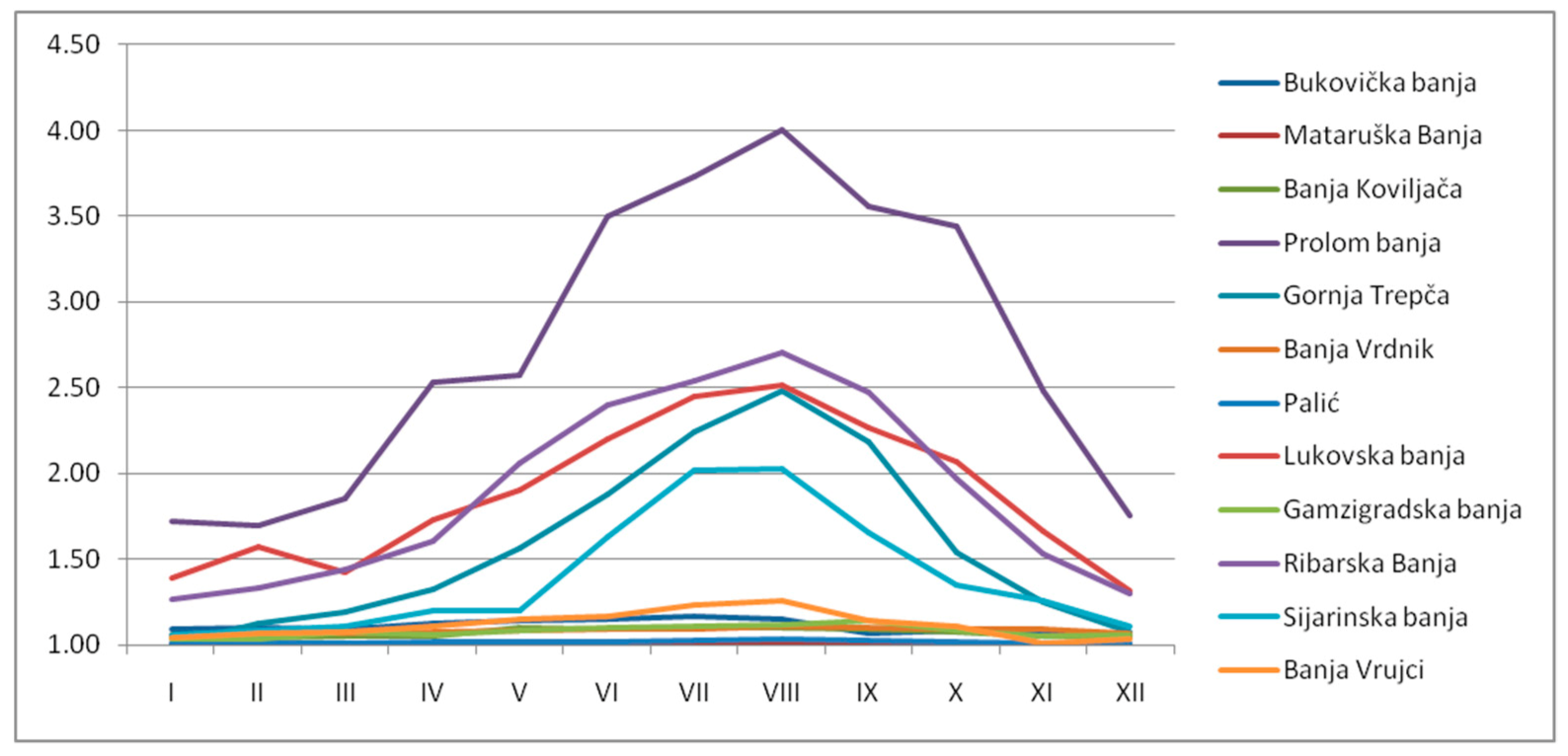
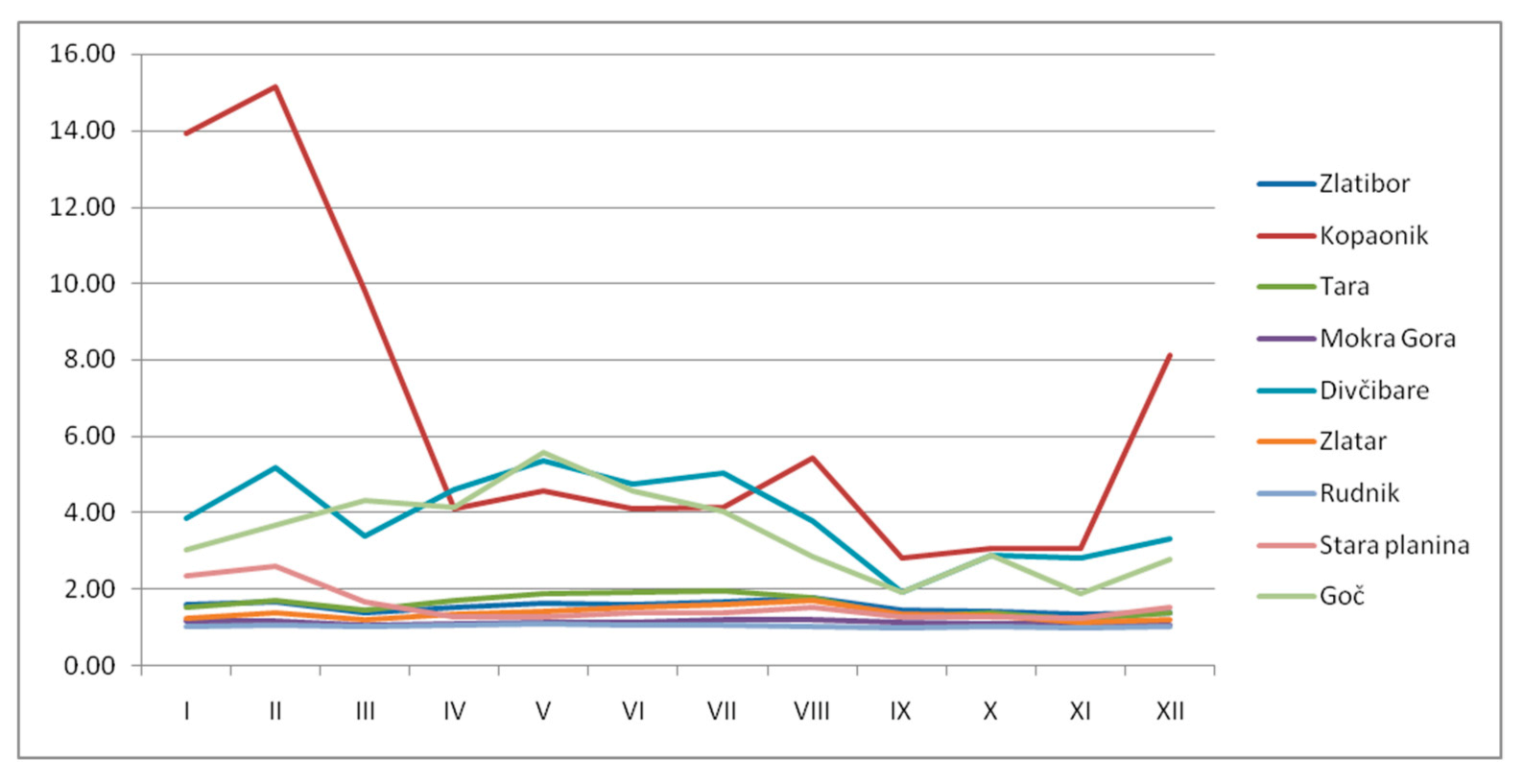


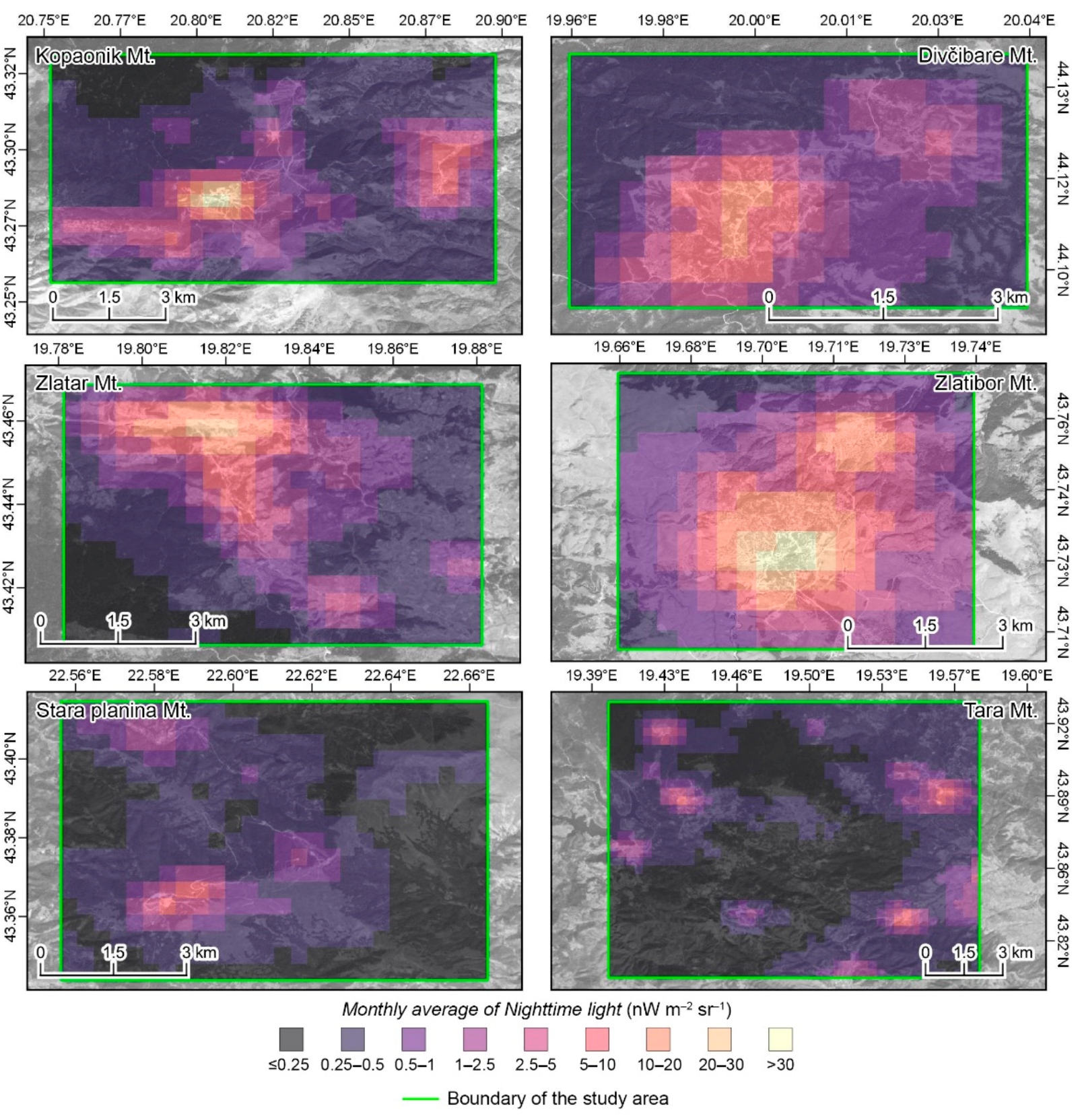
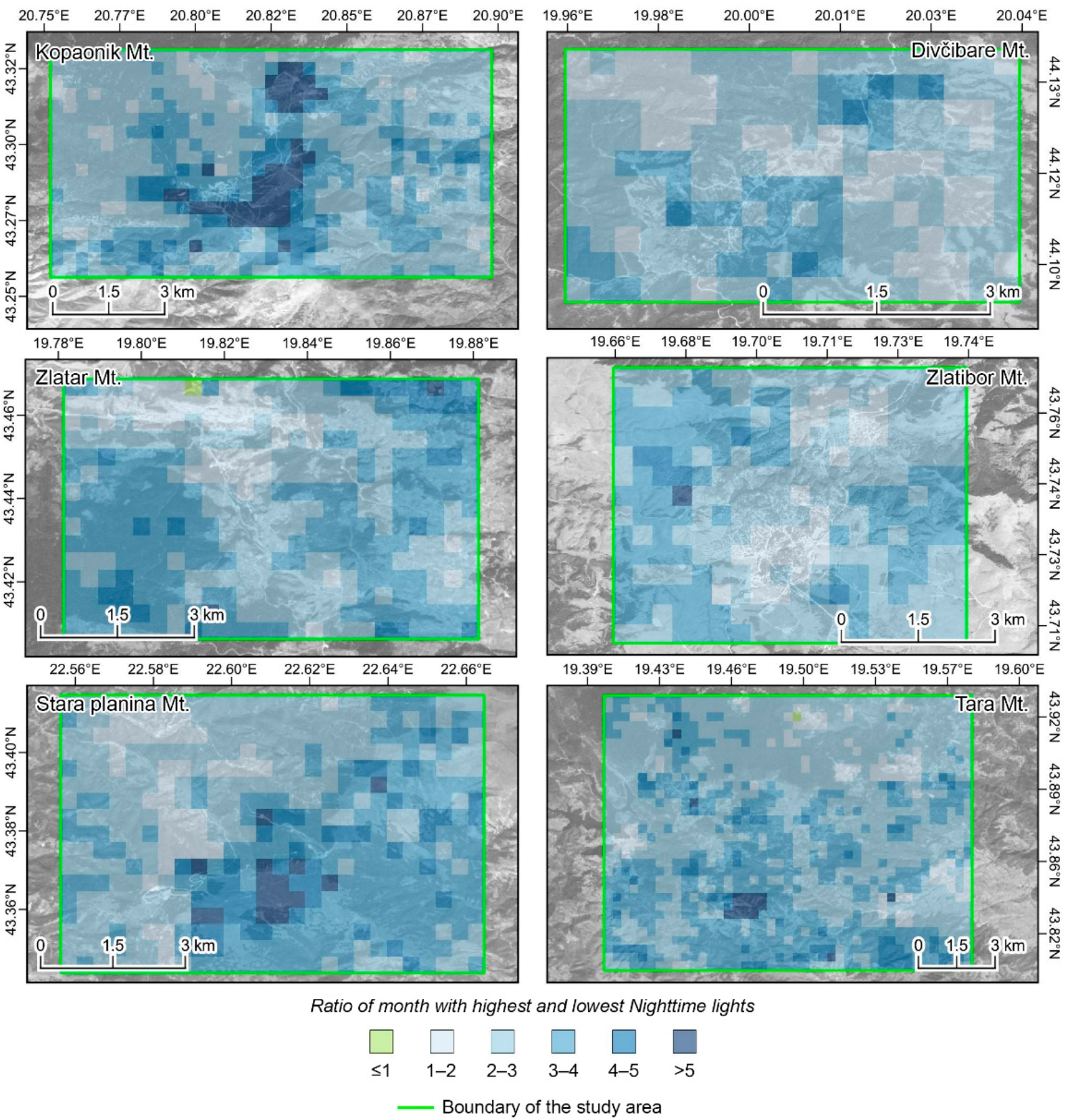
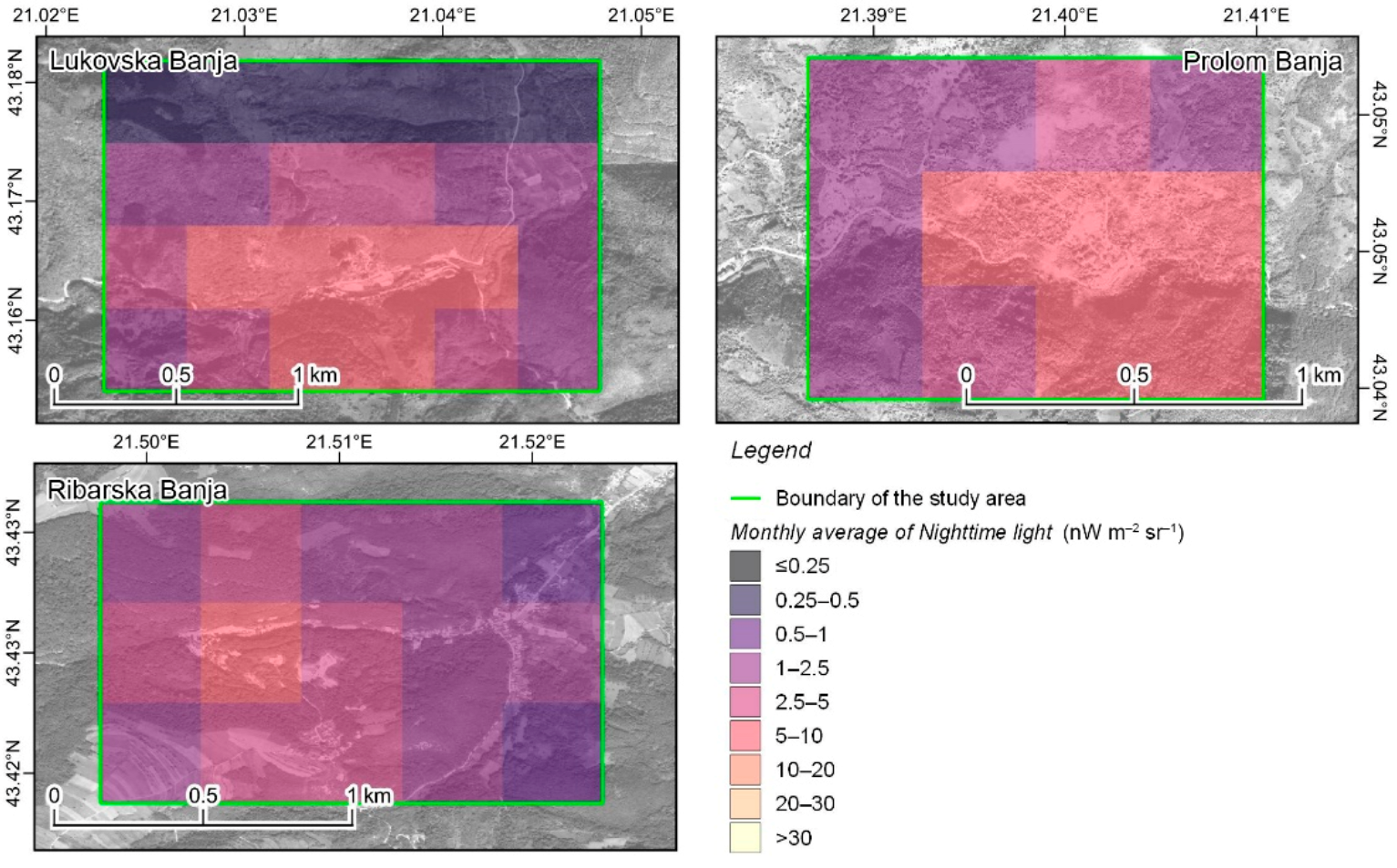
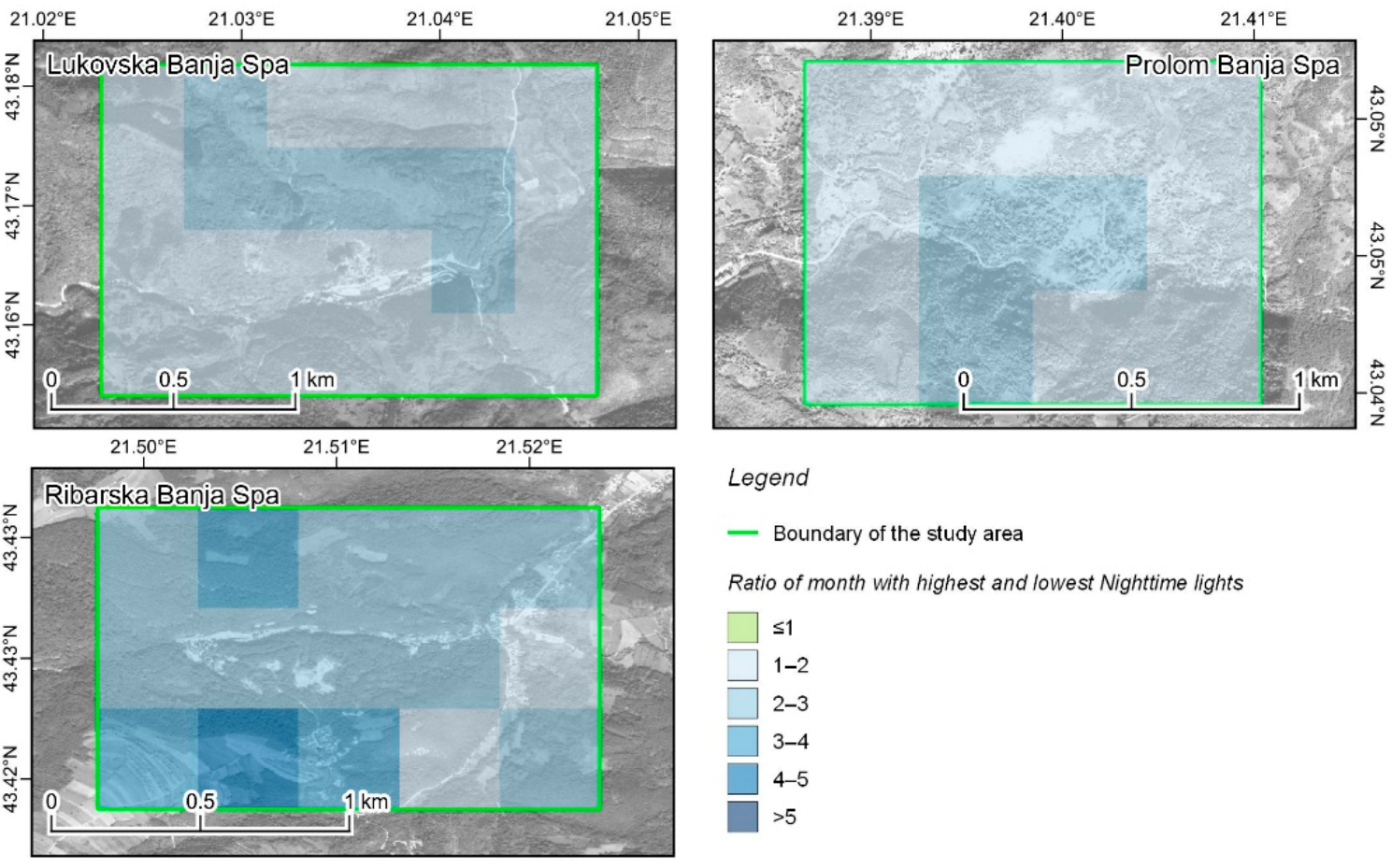
| Touristic Areas (Destination) | I | II | III | IV | V | VI | VII | VIII | IX | X | XI | XII |
|---|---|---|---|---|---|---|---|---|---|---|---|---|
| Spa centers | ||||||||||||
| Bukovačka Banja | 1.090 | 1.104 | 1.094 | 1.124 | 1.140 | 1.148 | 1.164 | 1.154 | 1.067 | 1.084 | 1.062 | 1.059 |
| Mataruška Banja | 1.006 | 1.004 | 1.006 | 1.005 | 1.007 | 1.006 | 1.007 | 1.009 | 1.010 | 1.003 | 1.001 | 1.002 |
| Banja Koviljača | 1.042 | 1.039 | 1.055 | 1.055 | 1.100 | 1.096 | 1.100 | 1.101 | 1.091 | 1.073 | 1.051 | 1.042 |
| Prolom banja | 1.717 | 1.698 | 1.853 | 2.535 | 2.570 | 3.496 | 3.732 | 4.005 | 3.557 | 3.443 | 2.485 | 1.755 |
| Gornja Trepča | 1.006 | 1.125 | 1.189 | 1.325 | 1.561 | 1.880 | 2.240 | 2.483 | 2.188 | 1.535 | 1.253 | 1.072 |
| Banja Vrdnik | 1.061 | 1.069 | 1.065 | 1.073 | 1.084 | 1.090 | 1.097 | 1.113 | 1.104 | 1.095 | 1.090 | 1.071 |
| Palić | 1.008 | 1.011 | 1.011 | 1.019 | 1.021 | 1.021 | 1.028 | 1.031 | 1.023 | 1.019 | 1.014 | 1.013 |
| Lukovska banja | 1.389 | 1.572 | 1.426 | 1.728 | 1.906 | 2.204 | 2.452 | 2.511 | 2.269 | 2.065 | 1.657 | 1.315 |
| Gamzigradska banja | 1.032 | 1.034 | 1.076 | 1.062 | 1.086 | 1.097 | 1.107 | 1.121 | 1.140 | 1.084 | 1.051 | 1.056 |
| Ribarska Banja | 1.264 | 1.328 | 1.439 | 1.606 | 2.064 | 2.396 | 2.542 | 2.708 | 2.477 | 1.966 | 1.529 | 1.301 |
| Sijarinska Banja | 1.063 | 1.081 | 1.108 | 1.199 | 1.197 | 1.629 | 2.019 | 2.028 | 1.651 | 1.346 | 1.255 | 1.105 |
| Banja Vrujci | 1.041 | 1.065 | 1.076 | 1.113 | 1.150 | 1.167 | 1.235 | 1.262 | 1.143 | 1.106 | 1.007 | 1.033 |
| Mountain areas | ||||||||||||
| Zlatibor | 1.596 | 1.659 | 1.403 | 1.520 | 1.613 | 1.592 | 1.666 | 1.763 | 1.457 | 1.439 | 1.356 | 1.391 |
| Kopaonik | 13.913 | 15.130 | 9.808 | 4.114 | 4.590 | 4.117 | 4.146 | 5.429 | 2.828 | 3.082 | 3.088 | 8.108 |
| Tara | 1.551 | 1.730 | 1.446 | 1.710 | 1.893 | 1.916 | 1.964 | 1.772 | 1.286 | 1.395 | 1.208 | 1.398 |
| Mokra Gora | 1.181 | 1.178 | 1.061 | 1.117 | 1.136 | 1.155 | 1.213 | 1.215 | 1.144 | 1.112 | 1.091 | 1.059 |
| Divčibare | 3.856 | 5.196 | 3.396 | 4.629 | 5.365 | 4.759 | 5.030 | 3.804 | 1.934 | 2.885 | 2.835 | 3.313 |
| Zlatar | 1.236 | 1.383 | 1.187 | 1.335 | 1.423 | 1.521 | 1.569 | 1.695 | 1.338 | 1.296 | 1.115 | 1.194 |
| Rudnik | 1.056 | 1.063 | 1.055 | 1.079 | 1.110 | 1.092 | 1.073 | 1.032 | 1.005 | 1.028 | 1.017 | 1.057 |
| Stara planina | 2.338 | 2.594 | 1.664 | 1.263 | 1.283 | 1.371 | 1.398 | 1.524 | 1.279 | 1.260 | 1.240 | 1.508 |
| Goč | 3.058 | 3.670 | 4.330 | 4.154 | 5.574 | 4.578 | 4.041 | 2.854 | 1.944 | 2.911 | 1.903 | 2.776 |
| Touristic Areas (Destination) | I | II | III | IV | V | VI | VII | VIII | IX | X | XI | XII |
|---|---|---|---|---|---|---|---|---|---|---|---|---|
| Divčibare Mt. | 1.92 | 1.60 | 1.12 | 0.83 | 0.71 | 0.73 | 0.76 | 0.78 | 0.81 | 0.83 | 0.93 | 0.97 |
| Stara planina Mt. | 1.76 | 1.51 | 1.19 | 0.86 | 0.85 | 0.78 | 0.61 | 0.71 | 0.71 | 0.86 | 1.05 | 1.12 |
| Kopaoonik Mt. | 2.01 | 1.58 | 1.38 | 0.87 | 0.65 | 0.59 | 0.61 | 0.66 | 0.69 | 0.74 | 0.95 | 1.28 |
| Zlatar Mt. | 1.66 | 1.34 | 1.01 | 0.88 | 0.81 | 0.80 | 0.78 | 0.85 | 0.82 | 0.86 | 1.02 | 1.18 |
| Zlatibor Mt. | 1.80 | 1.34 | 1.14 | 0.90 | 0.79 | 0.78 | 0.80 | 0.81 | 0.78 | 0.78 | 0.93 | 1.14 |
| Tara Mt. | 1.88 | 1.32 | 0.95 | 0.83 | 0.90 | 0.88 | 0.70 | 0.78 | 0.81 | 0.84 | 1.05 | 1.06 |
| Ribarska banja Spa | 2.00 | 1.07 | 0.84 | 0.87 | 0.82 | 0.76 | 0.74 | 0.83 | 0.87 | 0.86 | 1.15 | 1.17 |
| Prolom banja Spa | 1.26 | 0.68 | 0.86 | 0.98 | 0.95 | 0.97 | 1.02 | 1.10 | 1.06 | 1.0 | 1.13 | 1.0 |
| Lukovska banja Spa | 1.42 | 1.03 | 0.84 | 0.82 | 0.98 | 0.85 | 0.99 | 0.91 | 0.97 | 0.96 | 1.09 | 1.13 |
Publisher’s Note: MDPI stays neutral with regard to jurisdictional claims in published maps and institutional affiliations. |
© 2022 by the authors. Licensee MDPI, Basel, Switzerland. This article is an open access article distributed under the terms and conditions of the Creative Commons Attribution (CC BY) license (https://creativecommons.org/licenses/by/4.0/).
Share and Cite
Drobnjaković, M.; Panić, M.; Stanojević, G.; Doljak, D.; Kokotović Kanazir, V. Detection of the Seasonally Activated Rural Areas. Sustainability 2022, 14, 1604. https://doi.org/10.3390/su14031604
Drobnjaković M, Panić M, Stanojević G, Doljak D, Kokotović Kanazir V. Detection of the Seasonally Activated Rural Areas. Sustainability. 2022; 14(3):1604. https://doi.org/10.3390/su14031604
Chicago/Turabian StyleDrobnjaković, Marija, Milena Panić, Gorica Stanojević, Dejan Doljak, and Vlasta Kokotović Kanazir. 2022. "Detection of the Seasonally Activated Rural Areas" Sustainability 14, no. 3: 1604. https://doi.org/10.3390/su14031604
APA StyleDrobnjaković, M., Panić, M., Stanojević, G., Doljak, D., & Kokotović Kanazir, V. (2022). Detection of the Seasonally Activated Rural Areas. Sustainability, 14(3), 1604. https://doi.org/10.3390/su14031604








